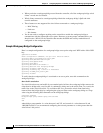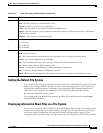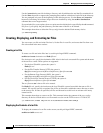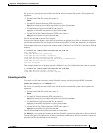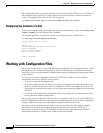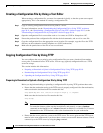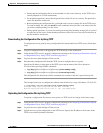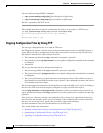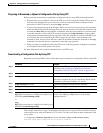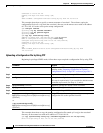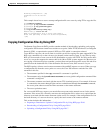
20-8
Cisco IOS Software Configuration Guide for Cisco Aironet Access Points
OL-11350-01
Chapter 20 Managing Firmware and Configurations
Working with Configuration Files
This example shows how to extract the contents of a tar file located on the TFTP server at 172.20.10.30.
This command extracts just the new-configs directory into the root directory on the local Flash file
system. The remaining files in the saved.tar file are ignored.
ap# archive tar /xtract tftp://172.20.10.30/saved.tar flash:/new-configs
Displaying the Contents of a File
To display the contents of any readable file, including a file on a remote file system, use the more [/ascii
| /binary | /ebcdic] file-url privileged EXEC command:
This example shows how to display the contents of a configuration file on a TFTP server:
ap# more tftp://serverA/hampton/savedconfig
!
! Saved configuration on server
!
version 11.3
service timestamps log datetime localtime
service linenumber
service udp-small-servers
service pt-vty-logging
!
<output truncated>
Working with Configuration Files
This section describes how to create, load, and maintain configuration files. Configuration files contain
commands entered to customize the function of the Cisco IOS software. To better benefit from these
instructions, your access point contains a minimal default running configuration for interacting with the
system software.
You can copy (download) configuration files from a TFTP, FTP, or RCP server to the running
configuration of the access point for various reasons:
• To restore a backed-up configuration file.
• To use the configuration file for another access point. For example, you might add another access
point to your network and want it to have a configuration similar to the original access point. By
copying the file to the new access point, you can change the relevant parts rather than recreating the
whole file.
• To load the same configuration commands on all the access points in your network so that all the
access points have similar configurations.
You can copy (upload) configuration files from the access point to a file server by using TFTP, FTP, or
RCP. You might perform this task to back up a current configuration file to a server before changing its
contents so that you can later restore the original configuration file from the server.
The protocol you use depends on which type of server you are using. The FTP and RCP transport
mechanisms provide faster performance and more reliable delivery of data than TFTP. These
improvements are possible because FTP and RCP are built on and use the Transmission Control
Protocol/Internet Protocol (TCP/IP) stack, which is connection oriented.



